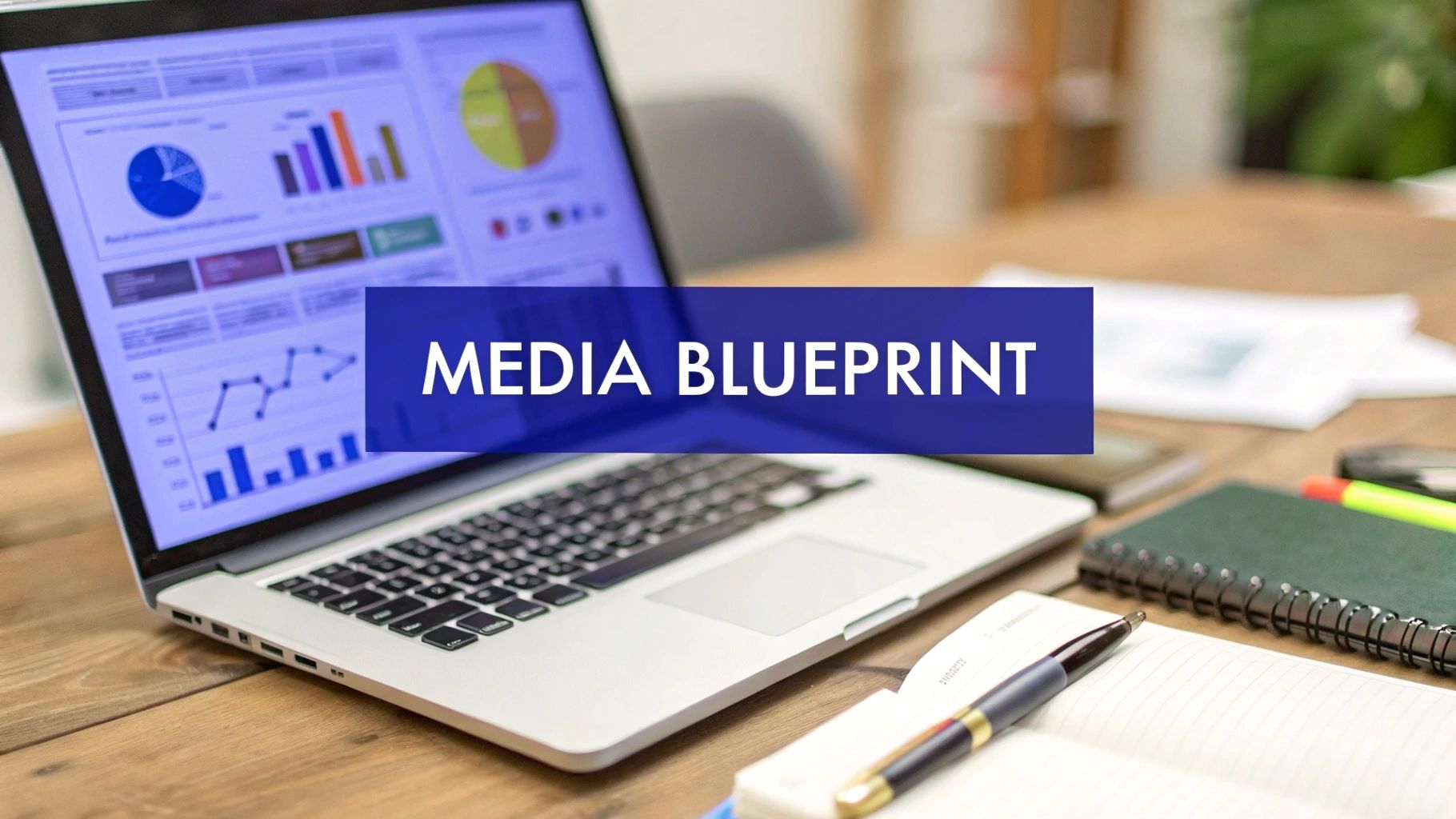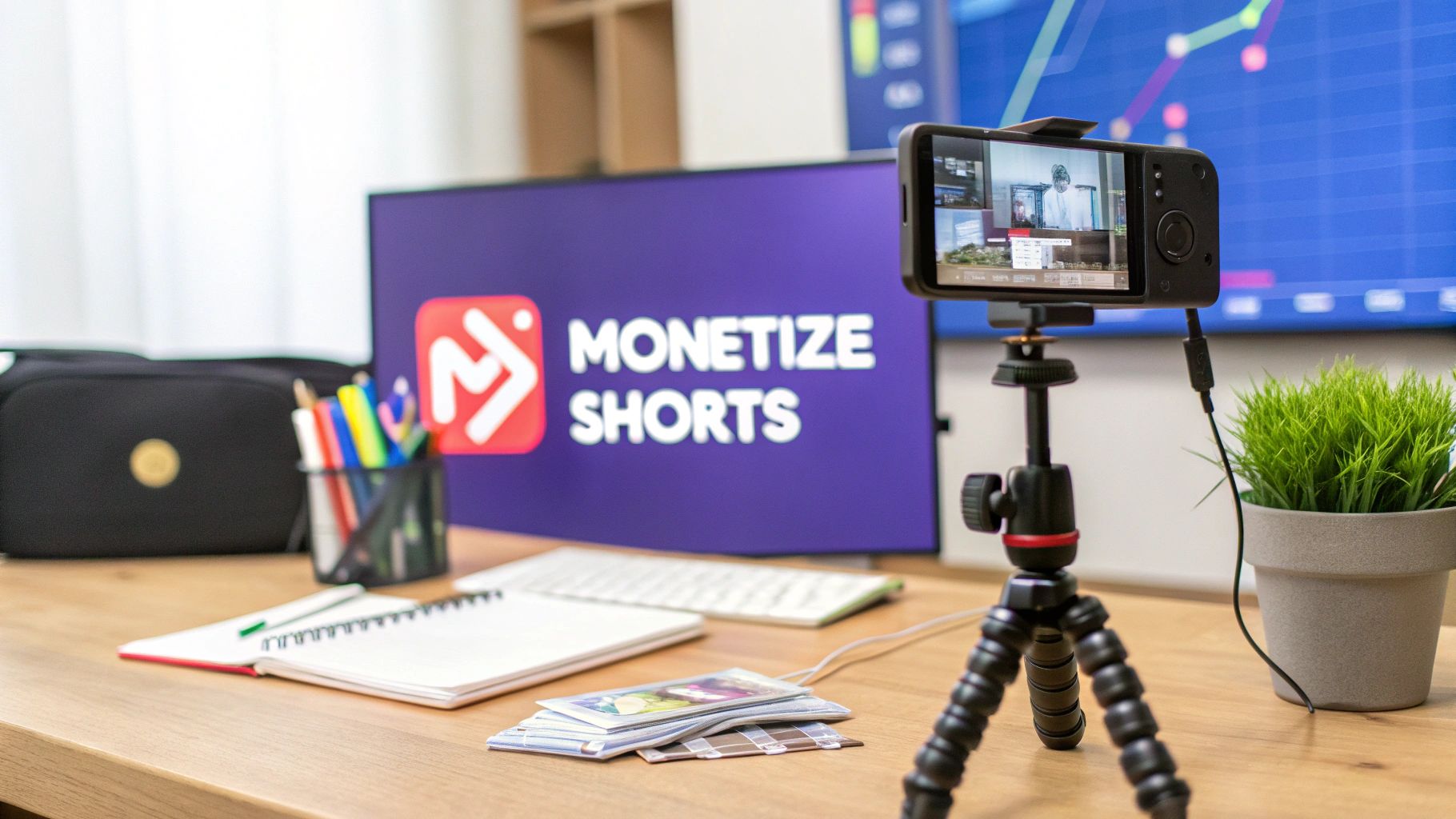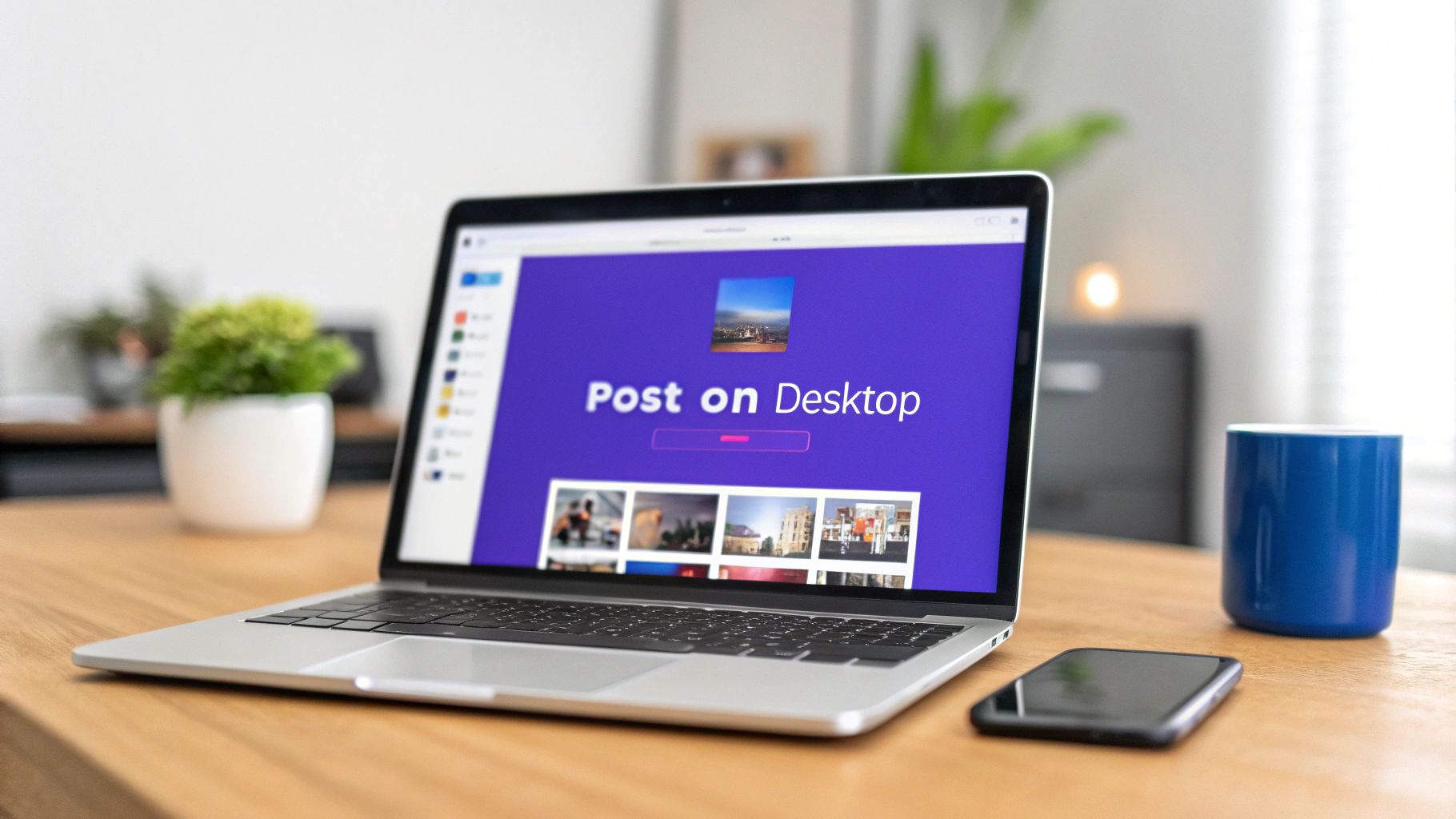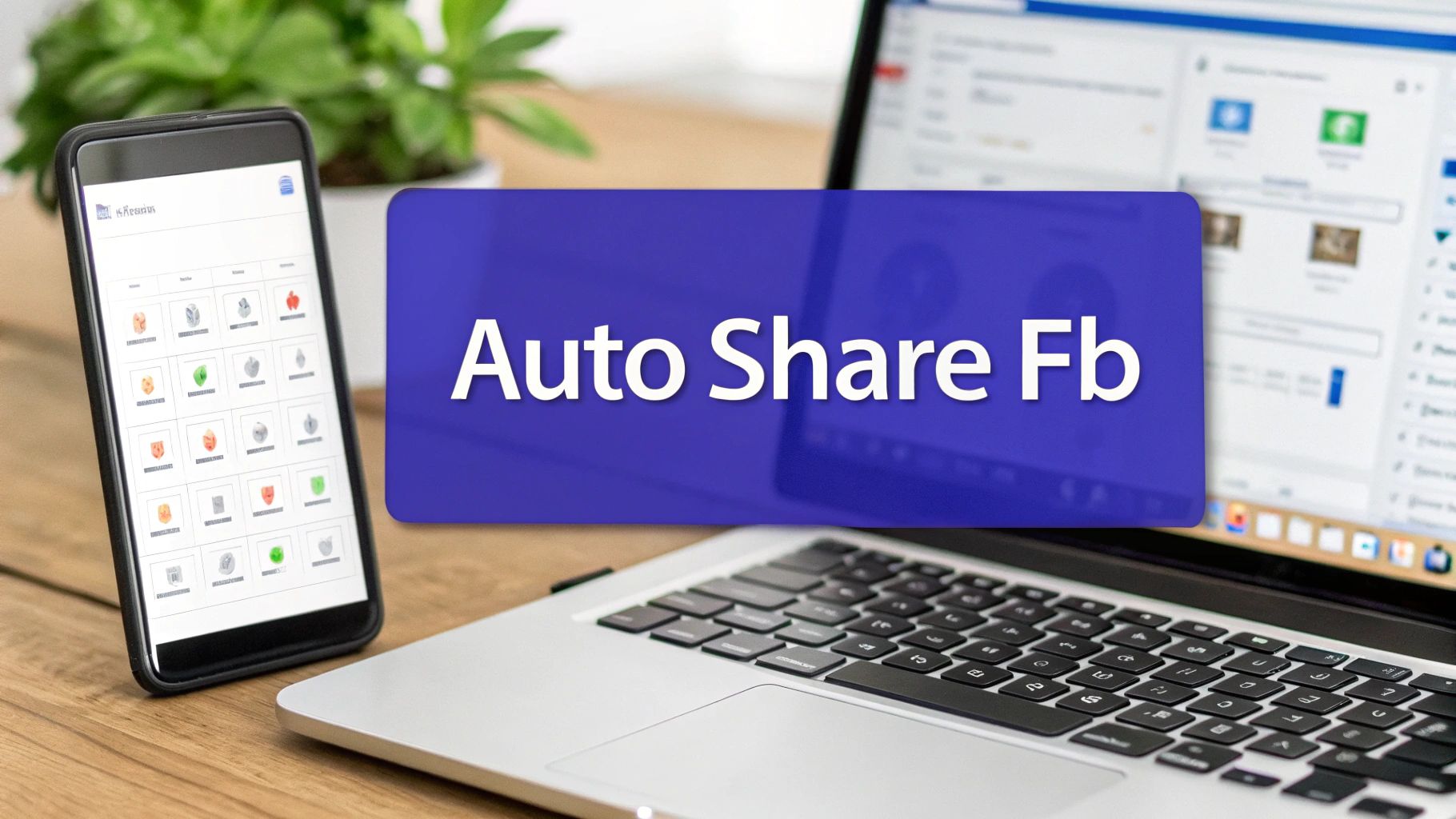Let's be real—a media plan template is so much more than another spreadsheet you have to fill out. It's the strategic roadmap that stops your advertising campaigns from turning into a chaotic mess of disconnected efforts. Think of it as the central command center that turns scattered marketing tactics into a unified, goal-crushing machine.
Why a Media Plan Is Your Strategic North Star
Before you even think about opening Excel or Google Sheets, it's critical to grasp what a good media plan actually does. It’s not just administrative busywork; it's the blueprint for every single marketing initiative you launch. Without one, teams end up working in silos, budgets get blown on the wrong channels, and figuring out what’s actually working becomes a nightmare.
A solid plan brings much-needed clarity. It gets everyone—from the social media manager running the ads to the CFO approving the budget—on the same page about the campaign's core objectives. That shared understanding is the secret sauce for executing a cohesive strategy across all your customer touchpoints.
Unifying Your Marketing Efforts
Picture your marketing activities like instruments in an orchestra. Paid search, social media ads, influencer marketing, and your blog content are all powerful on their own. But without a conductor holding the score—that's your media plan—all you get is noise. A great template brings harmony to the chaos, coordinating every paid, owned, and earned media channel so they work together.
This is what a simple, effective media plan template looks like in action.
See how it lays everything out? You can see the channel, the objective, the budget, and the core metrics all in one glance. That's the kind of high-level overview that keeps your entire strategy on track.
To help you get started, here's a breakdown of the essential components that every modern media plan template should include.
Core Components of a Modern Media Plan Template
This table summarizes the key fields your template needs to be truly effective. It's the difference between a simple list of channels and a comprehensive tool for managing your campaigns from start to finish.
| Component | Purpose | Example |
|---|---|---|
| Campaign Objective | Defines the primary goal of the campaign, ensuring all activities are aligned with a specific business outcome. | "Increase Q3 lead generation by 15%" |
| Target Audience | Specifies the demographic, psychographic, and behavioral traits of the ideal customer for this campaign. | "Tech-savvy millennials aged 25-34 interested in SaaS productivity tools" |
| Channels & Platforms | Lists the specific media channels (e.g., Social Media) and platforms (e.g., LinkedIn, TikTok) to be used. | "Paid Social: LinkedIn Ads, Instagram Stories" |
| Budget Allocation | Breaks down the total budget by channel, platform, and sometimes even by specific ad creative or format. | "$5,000 for LinkedIn Sponsored Content, $2,500 for Instagram Reel Ads" |
| Timeline & Flight Dates | Outlines the start and end dates for the overall campaign and for specific flights or pushes on each channel. | "Campaign runs from Oct 1 - Oct 31; LinkedIn flight from Oct 1 - Oct 15" |
| Key Performance Indicators (KPIs) | Identifies the primary metrics used to measure success for each channel and the overall campaign. | "Cost Per Lead (CPL) under $50; Click-Through Rate (CTR) above 2%" |
| Ad Formats & Creative | Details the specific types of ads to be used (e.g., video, carousel, static image) and creative concepts. | "Video testimonial ad for LinkedIn; user-generated content carousel for Instagram" |
Having these components built into your template ensures nothing falls through the cracks and that your plan is ready for execution from day one.
Building a Framework for Growth
A media plan template isn't a "set it and forget it" document. It’s a living, breathing tool that guides your ongoing optimizations. By creating a reliable framework for tracking what works (and what doesn't), you can start making smart, data-driven decisions that actually fuel growth. For more focused strategies, a detailed social media campaign template can be a fantastic supplement, drilling down into the specifics of a single channel while still aligning with the main plan.
A great media plan doesn't just list what you'll do; it explains why you're doing it. It connects every dollar spent and every piece of content created back to a tangible business objective, turning your marketing from a cost center into a revenue driver.
This strategic alignment is exactly what separates winning campaigns from expensive experiments. It gives you the confidence to double down on the right channels and the agility to pivot the moment performance data tells you to. Ultimately, it ensures your marketing efforts are always pulling you closer to your most important business goals.
Turning Big Business Goals into a Concrete Plan

Let’s be honest, a media plan template is more than just a fancy schedule. It’s the bridge between your lofty business ambitions and the actual marketing work that gets done. Goals like "increase sales" are fine for a boardroom meeting, but they're useless for a media plan. You need something sharp and measurable.
This is where you translate a high-level goal into a specific, trackable outcome. If the big-picture objective is to grab more market share, a concrete marketing goal could be to "increase qualified leads by 20% in Q4." See the difference? That simple shift gives you immediate clarity and a finish line you can actually see.
You Have to Know Who You're Talking To
Once your objective is locked in, the next question is simple but critical: who are you trying to reach? And I don't mean just basic demographics. You need to get into their heads. Where do they hang out online? What kind of content makes them stop scrolling? What problem are you actually solving for them?
Good audience research isn’t a one-and-done task. It’s a mix of a few key activities:
- Dig into your own data: Your CRM and analytics are goldmines. Look for common threads among your absolute best customers.
- Just ask them: Send out a quick survey to current customers. Ask them what podcasts they listen to or which industry newsletters they never miss.
- Be a fly on the wall: Spend some time on Reddit or in LinkedIn groups. You’ll find raw, unfiltered opinions about your industry and what people are struggling with.
This kind of digging prevents you from just throwing money at platforms where your audience isn't even active. It’s how you make sure your message lands in the right place, at the right time.
Key Takeaway: A media plan built on guesswork is a media plan that will fail. You have to know your audience intimately. Don't assume where they are—use data to prove it. Every single insight you gather is a weapon against your competition.
Building Your Media Mix: A Real-World Scenario
Let's walk through a practical example. Imagine a SaaS company launching a new AI-powered analytics tool for B2B marketers. Their primary goal is crystal clear: drive 500 demo requests for this new feature in the first 60 days.
That single goal dictates everything that comes next. Their target audience is marketing professionals, so they can immediately focus on channels where those folks are actively looking for business solutions.
Their media mix might break down like this:
| Channel | Rationale | Core KPI |
|---|---|---|
| LinkedIn Ads | You can target users directly by job title (like "Marketing Manager") and industry. It's a no-brainer. | Cost Per Lead (CPL) |
| Niche Podcast Sponsorships | Gets their brand in the ears of a super-dedicated audience listening to shows like "Marketing Over Coffee." | Demo Sign-ups |
| Industry Newsletter Ads | Puts their message right inside trusted publications their ideal customer is already reading every morning. | Click-Through Rate (CTR) |
Notice how every channel choice flows directly from the initial goal and the audience research? There’s no random guessing. This is the kind of strategic thinking that separates a winning campaign from a failed one.
If you want to go even deeper on planning for specific channels, our guide to creating a social media marketing plan template offers a more detailed framework. This method ensures every dollar you spend is a calculated move toward a measurable result, turning your template from a simple document into a true engine for business growth.
Mastering Your Media Budget and Allocation

Let's be honest, crafting a media budget can feel like you're throwing darts in the dark. But it really doesn’t have to be that way. The secret is to stop seeing your budget as one big, intimidating number and start treating it as a strategic puzzle. Your media plan template is the board where you put all the pieces together, giving every single dollar a job to do.
It doesn’t matter if you’re working with a tiny startup budget or a massive corporate one—the core idea is the same. You have to tie every cent you spend directly to a campaign goal. That's how you maximize your return on ad spend (ROAS) and prove your worth.
Choosing Your Budgeting Model
First things first, you need to decide how you're going to slice up the pie. There are two main ways to approach this, and the one you pick will dictate how you fill out your media plan.
- Channel-Based Budgeting: This is the most common and straightforward method. You simply assign a set amount to each platform. For example, $10,000 for Google Ads, $5,000 for your TikTok campaigns, and another $3,000 for influencer collaborations. It’s simple, easy to track, and great for getting started.
- Objective-Based Budgeting: This approach is a bit more strategic. You allocate money based on your goals. If your top priority is generating leads, you might push 60% of your budget to channels with the lowest cost-per-lead (like LinkedIn Ads) and the remaining 40% to awareness-focused channels like podcast sponsorships.
In my experience, a hybrid model is where the magic happens. You can set an initial budget for each channel but give yourself the freedom to move money around based on what’s actually working once the campaign is live.
A budget isn't meant to be a restriction; it's a roadmap. Map out your initial plan, but always be ready to pivot based on real-time data. The most successful campaigns are the ones that can adapt.
Visualizing Your Spend with a Media Calendar
Once you’ve decided where the money is going, a media calendar becomes your best friend. This isn't just about scheduling posts; it's a visual layout of your budget in action over weeks and months. This bird's-eye view is crucial for preventing you from accidentally blowing through your entire budget in the first week.
Think about it: an e-commerce brand will want to concentrate its ad spend around peak seasons like Black Friday. A B2B company, on the other hand, might load its budget at the beginning of the quarter to capture fresh leads. A good media plan template will have a calendar view baked right in to help you map all this out.
Looking at the bigger picture with annual media planning is what separates the pros from the amateurs. A large company might plan to allocate 40% of its yearly ad budget to digital, 30% to TV, and the rest to a mix of print and other media. In fact, enterprises that use detailed templates have boosted their budget efficiency by 15-25%. It just goes to show that careful planning pays off. For more on this, check out these insights on effective media plan budgeting on smartsheet.com. This kind of foresight ensures you maintain a strong, consistent presence all year long.
Taking Your Media Plan from Static to Strategic
A beautifully crafted media plan template is a great start, but let's be real—its value plummets the moment your campaign actually goes live. A static spreadsheet can't keep up with real-world performance. It quickly turns into a historical document instead of the strategic guide you need it to be. The real magic happens when you transform it from a simple forecast into a dynamic, living optimization engine.
So, how do you do that? You connect your plan to an execution platform. By integrating your template with a tool like PostSyncer, you finally bridge the massive gap between planning and doing. This connection completely eliminates the soul-crushing task of manually updating spreadsheets with performance data, a process that’s not only slow but also a magnet for human error.
Moving from Static Plans to Dynamic Workflows
Imagine this: your campaign results—click-through rates, engagement metrics, and conversion data—flow directly back into your plan in real time. No more waiting weeks for a report to tell you what happened. You get an immediate feedback loop.
This allows you to make agile, data-backed adjustments on the fly. You can reallocate your budget from an underperforming ad set to a winning one in minutes, not days. It's about being proactive, not reactive.
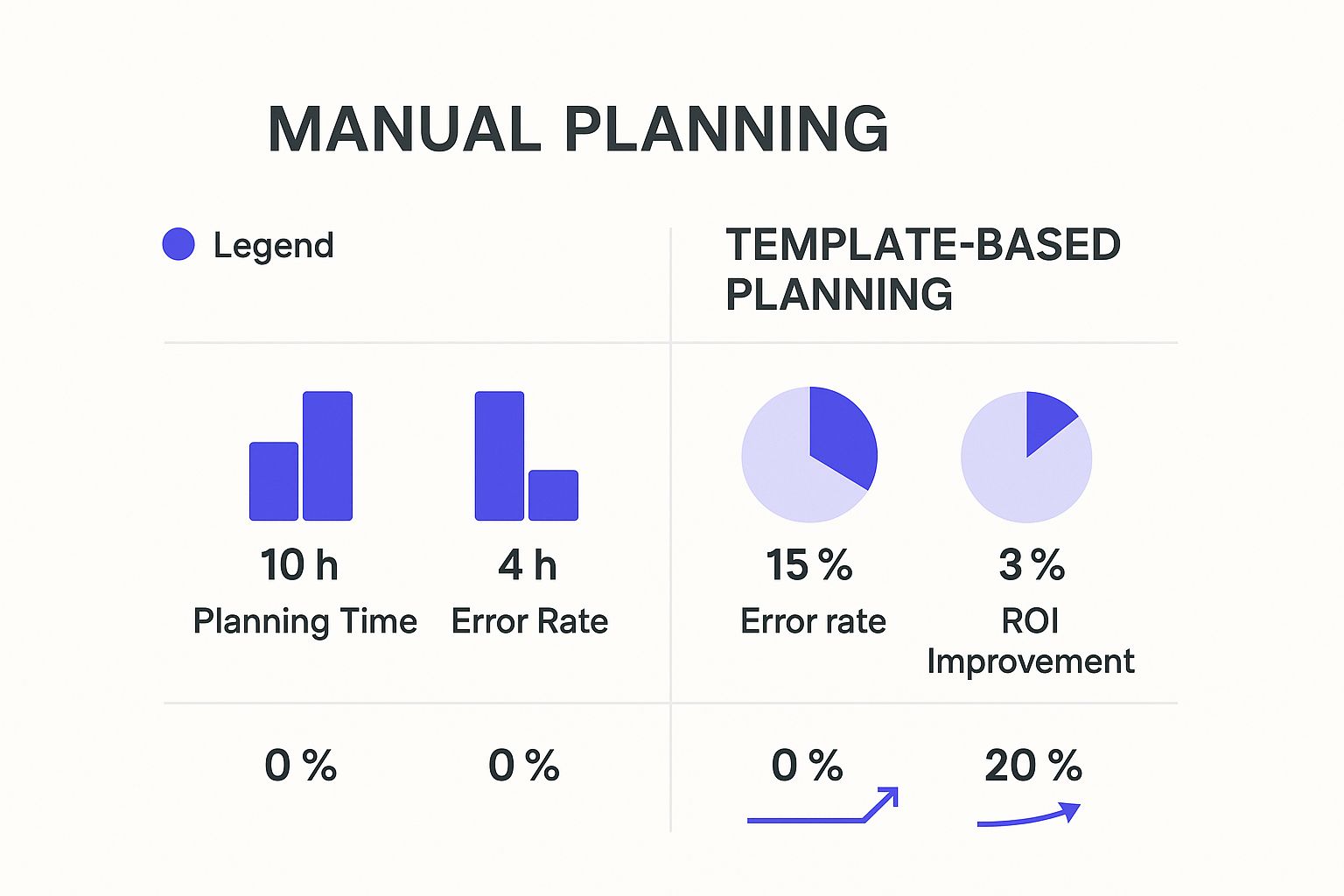
When you connect your planned activities to a central hub like this, you create a single source of truth for your entire media strategy. Everything is in one place, updated constantly.
Your media plan template becomes a living document. The workflow is simple but incredibly powerful:
- Plan: Start with your template to outline campaign goals, channels, budgets, and content.
- Execute: Schedule and publish your content directly through an integrated platform.
- Analyze: Watch as real-time performance data populates your dashboard automatically.
- Optimize: Use these immediate insights to refine your strategy without missing a beat.
The Clear Advantages of an Integrated Approach
Adopting an automated, template-based workflow isn't just a "nice-to-have." It has a measurable impact on both your efficiency and your results. The difference between the old manual way and a modern integrated approach is stark.
To put it in perspective, let's compare the two side-by-side.
Manual vs. PostSyncer-Integrated Media Planning
| Task | Manual Process | PostSyncer-Integrated Process |
|---|---|---|
| Data Entry | Hours spent manually copying and pasting performance metrics. | Data flows in automatically, no manual entry required. |
| Reporting | Weekly or monthly reports that are outdated on arrival. | Real-time dashboards provide instant performance visibility. |
| Optimization | Decisions based on old data, leading to slow adjustments. | Agile, in-the-moment changes based on live results. |
| Error Rate | High potential for copy-paste errors and miscalculations. | Dramatically reduced error rate due to automation. |
| Time Allocation | Majority of time spent on data collection and admin tasks. | Time is reallocated to high-value strategic thinking. |
The data speaks for itself. Shifting from clunky manual processes can lead to a 20% improvement in ROI, not to mention the massive time savings and drastic reduction in errors.
This efficiency isn't just about getting things done faster; it’s about reallocating that reclaimed time to more strategic work. When you're not buried in spreadsheets, you can focus on creative optimization, deep audience analysis, and high-level strategy that truly moves the needle.
Your media plan template should be the starting point, not the finish line. Integrating it with an execution tool transforms it from a static document into a command center that actively drives campaign success and maximizes your return on investment.
Ultimately, this integration ensures that every decision you make is informed by the most current data available. It empowers you to be proactive, making smarter choices that directly impact your bottom line and turning that well-structured plan into a true competitive advantage.
Tracking the Metrics That Actually Matter
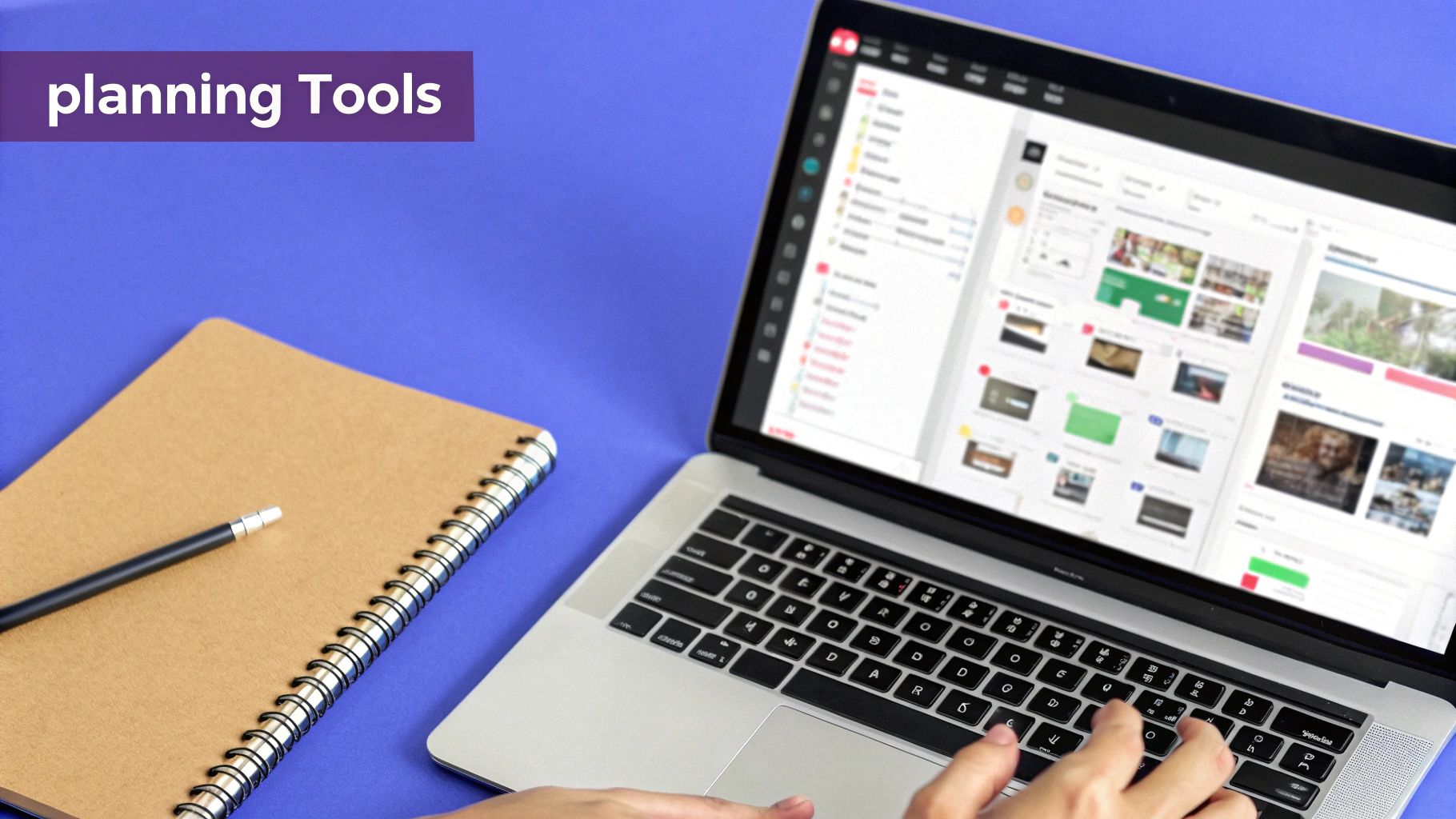
Let's be real: a media plan is just a document until it starts generating results. Once your campaigns go live, the real work begins. Your focus has to pivot from planning to measurement, because this is where you figure out what’s working and what’s just burning through your ad budget.
It’s way too easy to get caught up in vanity metrics. Things like follower counts or impressions look great on a report, but they don't actually tell you if you're making money. The goal isn't to look popular; it's to understand how every dollar you spend is impacting your bottom line.
Moving Beyond Vanity Metrics
To get a true sense of performance, you have to connect your metrics directly to your campaign goals. This isn't a one-size-fits-all situation. Different channels have different jobs, so you need to track different KPIs for each one.
For example, if you're running a paid social campaign on LinkedIn, your main goal is probably lead generation. That makes your Cost Per Acquisition (CPA) the most critical number. You need to know exactly how much it costs to get a single qualified lead through the door.
But what about something like a podcast sponsorship? That’s more about building brand awareness. In that case, you’d be looking at metrics like brand recall (which you can measure with a post-campaign survey) or how much direct traffic you get from a special URL mentioned in the ad. These numbers tell you if people are actually remembering your name.
Your media plan template should have a dedicated column for KPIs right next to each channel. This forces you to define what success looks like before you spend a single dollar, ensuring every activity is measurable and tied to a business goal.
Key KPIs for Different Channels
To make this super practical, here’s a quick breakdown of the main KPIs you should be tracking for the most common media channels. This isn't a complete list, but it's a solid foundation for any media plan.
- Paid Social (Facebook, Instagram, etc.): Keep a close eye on your Click-Through Rate (CTR)—this tells you if your ads are resonating. Then, track the Conversion Rate on your landing page to see if those clicks are turning into actual customers.
- Search Ads (Google Ads): Cost Per Click (CPC) and Quality Score are your bread and butter for efficiency. But the ultimate metric here is Return on Ad Spend (ROAS), which directly measures how profitable your ads are.
- Content Marketing (Blog Posts, etc.): Time on Page is a great indicator of how engaged your readers are. Also, look at New vs. Returning Users to understand if you're building a loyal audience.
- Influencer Marketing: Monitor the Engagement Rate on sponsored content. To track direct sales, always use unique Affiliate Links or Discount Codes.
Here's a little motivation for you: research shows that campaigns managed with a detailed media plan see 20-30% higher engagement and are far more cost-effective. Why? Because tracking this stuff in real-time lets you make smart adjustments on the fly.
Setting Up a Simple Dashboard
You don't need a fancy, expensive software suite to see how you're doing. You can build a simple dashboard right inside your spreadsheet-based media plan.
For a more automated approach, you can integrate your plan with a tool that has analytics built-in. For instance, a platform that handles social media scheduling and reporting can pull all this data for you automatically. It's a fantastic way to spot trends, see which channels are pulling their weight, and give clear, data-backed updates to your team or clients.
Got Questions About Media Plan Templates? We’ve Got Answers.
Even with the best template in hand, you're bound to have a few questions. I see it all the time. When you start building a plan from the ground up, certain sticking points always seem to pop up—from “How often should I even be posting?” to “When do I need to tear this thing up and start over?”
Getting clear, straightforward answers to these questions can make the whole process feel less like guesswork and more like a strategy.
One of the biggest hurdles is figuring out your posting frequency. Everyone wants a magic number, but the truth is, it doesn't exist. It really depends on the platform and how your audience behaves there. A fast-paced feed like X (formerly Twitter) might need several updates a day to stay relevant, whereas a single, high-value post on LinkedIn is often more than enough.
The goal isn't just to be loud; it's to be consistent. A solid media plan template helps you find a sustainable rhythm that keeps your audience tuned in without burning out your team.
Another common roadblock is figuring out how often to update the plan itself. A "set it and forget it" approach is a surefire way to waste time and money.
How Often Should You Revise Your Media Plan?
Think of your media plan as a living document, not something carved in stone. While the big-picture strategy might be set quarterly, you absolutely need to be checking in on your performance metrics every single week. This is what allows you to be nimble and make smart adjustments based on what the data is telling you.
Here’s a practical cadence I’ve seen work wonders:
- Weekly Check-in: Glance at your key performance indicators (KPIs). Are click-through rates holding steady? Is your cost per acquisition creeping up? This is your chance to tweak ad creative or shift a little budget around before small issues become big problems.
- Monthly Deep Dive: Now it’s time to zoom out a bit. Dig into which channels are giving you the best return on investment (ROI) and spot any larger trends. This is where you might decide to experiment with a new ad format or reallocate a more significant chunk of your budget.
- Quarterly Overhaul: This is your big strategy session. Revisit your core objectives. Have business goals shifted? Is there a new competitor on the scene? Use these insights to map out a fresh, informed plan for the next 90 days.
What's the Difference Between a Media Plan and a Content Calendar?
This is a big one. People often use these terms interchangeably, but they serve two very different, very important functions. Getting this distinction right brings a ton of clarity to your workflow.
Your media plan template is the strategic blueprint. It’s the high-level document that outlines your objectives, target audience, channels, budget, and the KPIs you’ll use to track everything. It answers the why, who, where, and how much.
A content calendar, on the other hand, is all about tactics and execution. It’s the day-to-day schedule that details the what and the when—the specific blog topics, the creative assets for an ad, the exact copy for a social post, and the precise time it goes live.
Basically, your media plan guides your content calendar. And knowing how to measure social media success is what connects them, ensuring your daily actions are actually moving you closer to your strategic goals.
Ready to stop wrestling with spreadsheets and turn your media planning into a streamlined, strategic process? PostSyncer gives you the AI-powered tools to plan, execute, and analyze your campaigns all in one place. Start making data-driven decisions with a platform built for growth. Start your free 7-day trial today!
